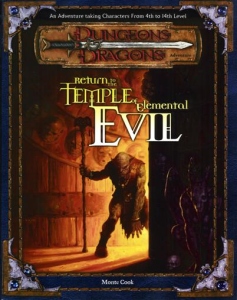 |
| (Source: Wikipedia) |
Now, don't get me wrong - D&D 3.5e is definitely stable, flexible and recognizable as D&D, but it's also very difficult to run if you go by the books. Broken builds are everywhere, and some of its mechanics are simply notorious (Grapple anyone?).
So I decided to do something I usually don't do. Run a 3.5e campaign using only the core books (PHB, DMG, MM) and throwing out all of the unneeded complexity. If I managed to run a D&D Next campaign that lasted 12 months by using a single die roll for Grappling, I don't see a reason to use 3.5e's interpretation of Grappling at the table.
Players are now free to use the flexibility and matureness of 3.5e to reconstruct their current characters, which is a good thing. D&D Next was simple to run (for both players and DMs), but that meant characters were not as complex as some players wanted. You couldn't make your character fit the picture you had in your mind, unless that character fell neatly into one of D&D Next's molds. 3.5e doesn't suffer from that.
The problem with 3.5e (IMHO) is that it's complex to run from the DM perspective, and it has some truly broken character builds.
I'll try to solve the broken build issue by limiting my players to the Core PHB book, but the complexity of 3.5e still remains. I mean, Attacks of Opportunity rules, Grappling, Sundering, Sneak Attack rules, Stacking rules, and basically everything Wizards wrote about in the Rules of the Game column years ago.
So what can I do? Here's what I think:
- Think story-wise, and not rules-wise. If a player tries a "complex" action (Sundering, Tripping, Grappling), there should be a roll involved, but that's it. The story (description, coolness factor of the action) is more important that the consequences of the action itself. And an adventure shouldn't end of the PCs manages to break the Vorpal Sword of their Vampire opponent.
- That said, the rules should not be ignored. I need to follow the "spirit" of the rules, even if I don't follow them to the letter. For example, the Mounted Combat rules are full of nuances (see here), but does the game break if I allow a PC riding a horse to just ride and attack giving a +1 to the attack? That said, the rules do specify some Skill checks and penalties to be taken into account when the PC is trying to perform some actions on horseback (ranged attack, spell casting), so I should not ignore them completely.
- Stay away from constructing NPC stat blocks that are detailed to the last spell/item. If possible, use Monster stat blocks, and stat blocks provided in books such as Enemies and Allies. Taking an hour to build a Mage NPC that will be killed in 3 rounds is a complete waste of time.
- And most important of all - keep the game running smoothly. Rules can be checked after the game ends, but they should be checked and explained, especially if a player tries to abuse them. It was hard to "abuse" something in D&D Next, as it had lots of blurred edges and the DM had a lot of say. But in 3.5e, a lot of rules are very detailed, making it hard for the DM to reject them or say "it doesn't work like that" without getting the players flipping the pages of the PHB. So rules should be applied, but in a way that is fair, helping the players (and the DM) create a fun and rewarding game experience.
Enjoy!

No comments:
Post a Comment